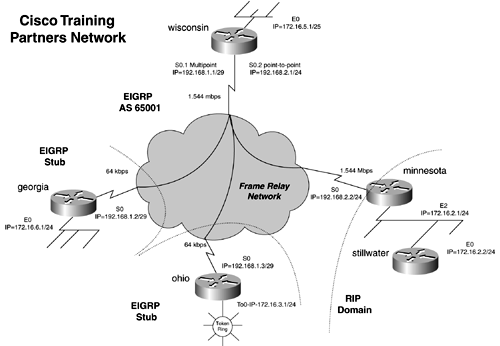Configuring OSPF Stub Areas
| < Free Open Study > |
Lab 22: EIGRP Route Redistribution, Summarization, and Stub Routing ”Part IPractical ScenarioAs EIGRP networks continue to grow in popularity, it becomes increasingly important to be able to control the query range and integrate it with other routing protocols, such as RIP and OSPF. It is also important to understand the default setting of EIGRP, such as split horizon and autosummarization. This lab gives you practice in controlling the query range, integrating EIGRP with other routing protocols, and performing summarization. Lab ExerciseCisco Training Partners provide custom-tailored Cisco courses around the United States and are in the process of integrating their training facilities over a common network. Your task is to configure an EIGRP network using the following parameters as design guidelines:
Lab Objectives
Equipment Needed
Physical Layout and Prestaging
Example 11-31 Frame Relay Switch Configurationhostname frame_switch ! frame-relay switching ! <<<text omitted>>> ! interface Serial0 no ip address encapsulation frame-relay no fair-queue clockrate 148000 frame-relay intf-type dce frame-relay route 111 interface Serial1 110 frame-relay route 121 interface Serial3 102 frame-relay route 150 interface Serial5 151 ! interface Serial1 no ip address encapsulation frame-relay clockrate 148000 frame-relay intf-type dce frame-relay route 110 interface Serial0 111 ! <<<text omitted>>> ! interface Serial3 no ip address encapsulation frame-relay clockrate 64000 frame-relay intf-type dce frame-relay route 102 interface Serial0 121 ! <<<text omitted>>> ! interface Serial5 no ip address encapsulation frame-relay clockrate 64000 frame-relay intf-type dce frame-relay route 151 interface Serial0 150 ! |
| < Free Open Study > |
EAN: 2147483647
Pages: 283
- ERP System Acquisition: A Process Model and Results From an Austrian Survey
- The Second Wave ERP Market: An Australian Viewpoint
- Enterprise Application Integration: New Solutions for a Solved Problem or a Challenging Research Field?
- Healthcare Information: From Administrative to Practice Databases
- A Hybrid Clustering Technique to Improve Patient Data Quality
